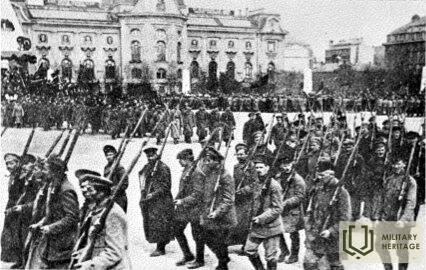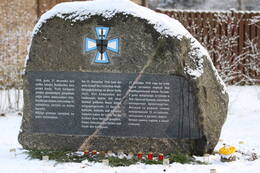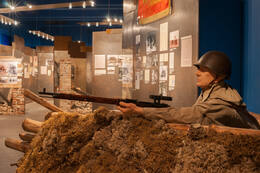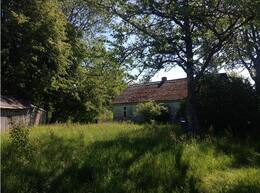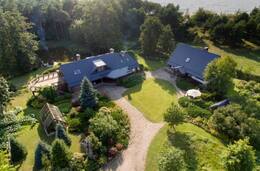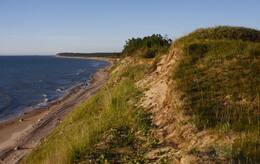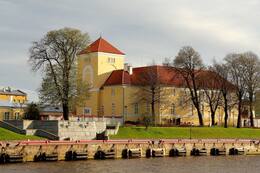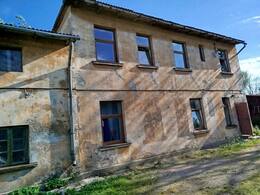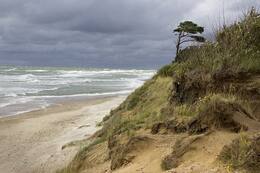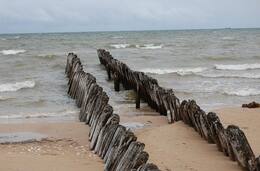The Red Army occupies Riga I Wars of Independence
At the end of December 1918, the Red Army had approached Riga from the north, east and south. The 2nd Latvian Rifle Brigade was moving from Cēsis to Riga, but along the two banks of the Daugava - the 1st Latvian Rifle Brigade and the Russian 2nd Novgorod Rifle Division Regiment. The last unsuccessful attempt to stop the Red Army on the outskirts of Riga took place at the turn of the year near Inčukalns. Here, Landeswehr's ornaments, along with the Iron Brigade (it was the German army units that agreed to fight the Bolsheviks) and the Russian anti-nobility units, suffered a heavy defeat in the two-day battle with the 1st and 4th Latvian Rifle Regiments.
With the hope of stopping the approach of the Red Army and the "red" Latvian riflemen in it, at noon on January 2, 1919, the Provisional Government led by K. Ulmanis, accompanied by the Student Company, left Riga. On the morning of January 3, other national troops entrusted to the government, a total of about 400 soldiers under Colonel Oscar Kalpak, also left the city. Most of the newly formed national army deserted because they did not want to fight the "red" Latvian riflemen. The calculation of the Russian Communists, involving the regiments of the Latvian Soviet Rifle Division in the invasion of the Baltics, was completely justified. English warships and several thousand refugees also left the city.
On the night of January 2, an armed uprising of the Bolsheviks began in Riga. All night long, and on January 3, there were chaotic clashes between the Bolshevik militants, the gang of robbers and the remaining anti-military forces in the city. Hundreds of prisoners had escaped and hundreds of prisoners had been released (600 from the Term Prison alone). 22 people were killed in clashes with the Iron Brigade and some Landeswehr units near the Riga railway station, the elevator and the Second City Theater (now the Latvian National Theater).
On the afternoon of January 3, 1919, the first groups of rifle scouts entered Riga. In the afternoon and evening, the 6th Latvian Rifle Regiment, transferred from Valka, entered the city. On the night of January 4, the Provisional Soviet government led by Peter Stucka arrived by train to the ruined Jugla Bridge. Its members boarded an armored train deprived of the Germans and entered Riga at night. Already at three in the morning, representatives of the Soviet government took part in a meeting of the Riga War Revolutionary Committee, which was the leader of the Bolshevik-led uprising. The reign of the Bolsheviks began in Riga in less than five months.
More information sources
Blizzard. The "Red Riflemen" enter Riga. Available: https://www.dveseluputenis.lv/lv/laika-skala/notikums/106/sarkanie-strelnieki-ieiet-riga/ [accessed 06.05.2021].
Related timeline
Related objects
Monument to the first battle for Latvia's independence
Atroadas, Inčukalns, Atmodas Street 2.
On July 3, 2016, a monument to the first battle for Latvia's independence, dedicated to the Latvian National Guard (Die Lettländische Landeswehr), was unveiled. sides. Eižens Upmanis, the chairman of the Brothers' Cemetery Committee, concluded at the time that this could be the historically first monument to the combined Latvian and Baltic forces in the battle memorials outside the cemetery. At that time, Lieutenant Colonel Oskars Kalpaks was appointed commander of the Latvian units of the Latvian National Guard or Landesver, from whose units the later Latvian army grew and formed during the Freedom Fights.
In 1918, the entire territory of present-day Latvia had fallen into the hands of the German Empire and its troops. However, at the end of the summer and autumn of 1918, the situation began to end badly for Germany, and it was clear that it was only a matter of time before Germany would be forced to concede defeat in World War I. The Russian Empire, which included Latvia before World War I, had ceased to exist earlier, with the revolutions of February and October 1917. On November 18, 1918, the Republic of Latvia was proclaimed. After the ceasefire with the Entente on November 11, 1918, the German army, which was on the territory of Latvia, was no longer motivated for further warfare, and most of its soldiers simply wanted to return home.
Under such circumstances, it was clear that Latvia's defense depended primarily on the national guard formed by the people of Latvia. Initially, due to their education and relatively greater ability to self-organize, the greatest initiative in creating such a national guard was shown by the Baltic Germans living in Latvia. Russian soldiers also joined the National Guard. In order to ensure the supply of the National Guard with uniforms, weapons and other necessary resources, on December 7, 1918, the Provisional Government of Latvia entered into an agreement with the German representative August Vinnig, providing for the provision of the National Guard from the German army reserves in Latvia. This agreement stated, among other things, that the National Guard, officially known as the Latvian National Guard or in German, the die Lettländische Landeswehr, would be the armed forces of the Republic of Latvia.
Two soldiers of the Latvian Red Rifle Regiment (ie approximately 2,000 to 3,000 soldiers) who had previously experienced in World War I and the Russian Civil War faced the Latvian National Guard. Despite the experience and numerical superiority of the Red Army, the Latvian National Guard held Inčukalns for two days in fierce fighting, until finally, in the evening of January 1, 1919, to avoid siege, was forced to retire, losing 43 dead and several wounded, most of whom was taken captive by the Bolsheviks, where they were killed or died of starvation or disease.
Author: Artis Buks. Material: Boulder. The monument is made of large monolithic stone, which was found in Rolls near Jelgava.
Latvian War Museum
The Latvian War Museum is located in the Old Town not far from the Freedom Monument in a historic defence building called the ‘Powder Tower’. There are 11 exhibits in the museum. There are various weapons, documents, uniforms, awards, badges and other items detailing the everyday life of a soldier in war. The Latvian War Museum is one of the oldest museums in Latvia. Its origins can be found in World War I. Museum’s collection was made up mainly of personal items of soldiers or items found on battlefields. After Latvia gained its independence the main goal of the museum became to create an exposition on the military history of Latvia and the active role of the population in protecting their land. In 1937 the museum was expanded and was technically one of the most modern museums in Europe at that time. The Powder Tower was one of the fortification towers of Riga. Some evidence dates back to 1330 where it has been mentioned as the ‘Sand Tower’. The tower was destroyed in 1621 when Riga was besieged by the Swedish Army. But in 1650 a new tower for storing gunpowder and weapons was built. After the city’s fortifications were taken down, the Powder Tower remains as one of the most important pieces of evidence of the Riga defence system.
"Laukgaļi" house, writer Kārlis Skalbe's place of residence
"Laukgaļi" in Jūrkalne parish, the writer Kārlis Skalbe's place of residence in October-November 1944, while waiting for the refugee boat to Sweden.
"Bambaļi" houses - one of the main places of accommodation for boat refugees
The restored "Bambaļi" houses in Ošvalki, Jūrkalne parish, were one of the main places of settlement for boat refugees on the coast of Kurzeme.
Refugee temporary accommodation "Vārve huts"
Vārves "huts", a place in Ventspils county, which served as a temporary accommodation for Latvian refugees who were waiting for boats from Gotland to arrive in 1944.
Prison in the castle of the Livonian Order during World War II
1944-1945 in the prison set up in Livonia Oden Castle. In 2010, several members of the LCP Ventspils communication group and the movers of refugee boats were detained.
The building in Ventspils, where LCP liaison Valentine Jaunzeme (Lasmane) lived in 1944
House at Lauku Street 4, Ventspils, where the teacher teacher Valentīne Lasmane (b. Jaunzeme) (1916–2018) lived and worked, who in 1944-1945 worked as LCP liaison and member of Ventspils communication group. Lived in Sweden after World War II. She compiled the testimonies of 130 boat refugees in the publication "Across the Sea 1944/1945." (Stockholm, 1990), but V. Lasmane's own life story can be read in the book "The night is not just for sleeping" (Riga, 2020). In 2000, she was awarded the Order of Three Stars. Died at the age of 102 in 2018 in the Stockholm suburb of Tebia.
Staldzene steep bank, from which refugee boats to Sweden were transported in 1944
In 1944, there was an active traffic of refugee boats to the shores of Sweden from Staldzene.
The coast of Mazirbe, from where the refugee boat traffic to Sweden took place in 1944
The coast of Mazirbe was an important place in the Second World War, from where the traffic of refugee boats to Sweden took place in 1944.
Related stories
The bombing of Rezekne in 1944
The bombing of Rēzekne took place at Easter 1944, and as a result a large part of the city's buildings were destroyed and dozens of civilians were killed, while several thousand more were left homeless. People who have experienced these events on their own skin and can tell us about them were children at the time. One of them is also the author of this story.
Rescue the Nega River Bridge from blasting
By the time the Germans retreated in 1944, many important sites had been blown up and it was very difficult to prevent, but there are also stories of miraculous events where the courage of the locals and the tolerance of a soldier allow salmon to survive in places important to the locals. One of the stories is also about a discussion between a housewife and a German soldier who saved an entire bridge from being blown up.
Efforts to prevent the blowing up of Ķegums HPP
During the Second World War, when the armies retreated, a large part of the militarily and logistically important objects in Latvia were blown up, so that these resources would not remain with the current opponents. Such objects were also in the vicinity of Ķegums, where one of the most important objects is the Ķegums HPP, which, however, was not completely destroyed due to the efforts and efforts of its employees.




